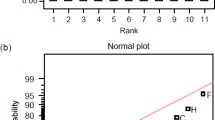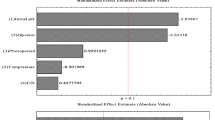Abstract
The effects of cultural parameters such as carbon and nitrogen source and environmental factors including temperature and pH were investigated on spore and mycelial yield of Trichoderma viride, which has potential as a biocontrol agent against species of Fusarium in batch culture and fed-batch culture where there was limiting nutrient. The results obtained indicated that growth and sporulation of T. viride were greatly influenced by various carbon and nitrogen sources, and by environmental factors such as pH and temperature. Mannitol, wheat bran and rice bran as sole carbon sources appear to stimulate high mycelial growth and spore yield in fed-batch culture. Growth and sporulation were also favoured by NaNO3, peptone and NH4SO4 as the nitrogen sources in fed-batch and batch cultures. Maximum growth and sporulation was between pH 4.5 and 6.0. Temperatures between 30 and 37 °C were good for mycelium growth of T. viride while temperatures between 30 to 45 °C were good for sporulation. The amount of spore and mycelium produced and the time required for attainment of maximum spore yield increased with increasing carbon and nitrogen source in batch culture. The final spore yield obtained in fed-batch culture was two times higher than the apparent spore-carrying capacity of batch culture. These results show that T. viride is capable of growing and sporulating with varied nutritional and environmental conditions, and, therefore, this strain of T. viride may be useful as a biocontrol agent under diverse physiological and environmental conditions.






Similar content being viewed by others
References
Ahmed JS, Baker R (1987) Competitive saprophytic ability and cellulolytic activity of rhizophere-competent mutants of Trichoderma harzianum. Phytopathology 77:358–362
Al-Taweil HI, Osman MB, Aidil AH, Yussof WMW (2009) Optimizing Trichoderma viride Cultivation in Submerged State Fermentation. Am J Appl Sc 6(7):1277–1281
Andrew JH, Harris RF (1997) Dormancy, Germination, Growth, Sporulation, and Dispersal. In: Esser K, Lemke PA (eds) The Mycota IV. Springer, Berlin, pp 3–13
Aube C, Gagnon C (1969) Effect of carbon and Nitrogen nutrition on growth and sporulation of Trichoderma viride pers Ex fries. Can J Microbiol 15:703–706
Bastos CN (2001) Effect of temperature, pH and nutrition on growth and sporulation of Trichoderma stromaticum sp. nov; An antagonist of cocoa witches broom pathogen. Summa Phytopathology 27:73–76
Benhamou N, Chet I (1993) Hyphal interctions between Trichoderma harzianum and Rhizoctonia solani: ultrastructure band gold cytochemistry of themycoparasitic process. Phytopathology 83:1062–1107
Cascino JJ, Harris RF, Smith CS, Andrew JH (1990) Spore yield and Microcycle Conidiation of Colletotrichum gloeosporioides in Liquid Culture. Appl Environ Microbiol 56(8):2303–2310
Churchill BW (1982) Mass production of microorganisms for biological control. In: Charudattan R, Walker HL (eds) Biological control of weeds with plant pathogens. Wiley, New York, pp 139–156
Cochrane VW (1958) Physiology of fungi. Wiley, London
Coppings LG, Menn JJ (2000) Biopesticides: a review of their astion, applications and efficacy. Pest Manag Sci 56:651–676
Esan TE, Oancea F (2010) Trichoderma viride pers. – Experimental model for biological and biotechnological investigations of mycromyceta with importance in obtaining Plant protection bioproducts. J Plant Dev 17:49–62
Grffin DH (1994) Fungal Physiology, 2nd edn. Wiley Liss, New York
Ibrahim YB, Low W (1993) Potential of Mass Production and Field Efficacy of Isolates of the Entomopathoghenic Fungi Beauveria bassiana and Paecilomyces fumosoroseus on Plutella xylostella. J Invert Pathol 39:222–232
Jayaswal KR, Singhl R, Su-Lee Y (2003) Influence of Physiological and Environmental Factors on Growth and Sporulation of an Antagonistic Strain of Trichoderma viride RSR 7. Korean Soc Mycol 31(1):36–41
Lewis JA, Papavivaz GC (1983) Production of chlamydospores and conidia by Trichoderma sp. in liquid and solid growth media. Soil Biol Biochem 15:351–357
Lisansky SG, Hall RA (1983) Fungal control of insects. In: Smith JE, Berry DR, Kristiansen B (eds) The filamentous fungi, vol 4. Fungal technology. Edward Arnold, London, pp 327–345
MacNish GC (1988) Changes in take-all (Gaeumannomyces graminis var. tritici), rhizoctonia root rot (Rhizoctonia solani) and soil pH in continuous wheat with annual application of nitrogenous fertilizer in Western Australia. Aust J Exp Agr) 28:333–341
Morton, AG (1961) The induction of sporulation in mould fungi. Proc R Soc Lond B 153:548-569
Nahar S, Hossain F, Feroza B, Halim MA (2008) Production of glucoamylase by Rhizopus sp. in liquid culture. Pak J Bot 40(4):1693–1698
Nicholas DJD (1965) Utilization of inorganic nitrogen compounds and amino acids by fungi. In: Ainsworth GC, Sussman AS (eds) The fungi, vol 2. Academic, New York, pp 349–376
Papavizas GC (1995) Trichoderma and Gliocladium: biology, ecology, and potential for biological control. Annu Rev Phytopathol 23:23–54
Roussos S, Raimbault M, Viniegra-Gonzalez G, Saucedo-Castraneda G, Lonsane BK (1991) Scale-up of cellulases production by Trichoderma harzianum on amixture of sugar cane baggase and wheat bran in solid state fermentation system. Micol Neotrop Apl 4:83–98
Schlegel GH (2002) General Microbiology, 7th edn. Cambridge University Press, Cambridge, pp 246–249
Sharma S, Gupta RBL, Yadava CPS (2002) Selection of a suitable medium for mass multiplication of Entomofungal pathogens. Ind J Entomol 64(3):254–261
Steyaert JM, Weld RJ, Stewart A (2010) Ambient pH intrinsically influences Trichoderma conidiation and colony morphology. Fungal Biol 114:198–208
Tronsmo A, Dennis C (1978) Effect of temperature on antagonistic properties of Trichoderma species. Trans Br Mycol Soc 71:469–474
Whipps JM, Lumsden RD (2001) Commercial use of fungi as plant disease biological control agents: status and prospects. In: Butts T, Jackson C, Magan N (eds) Fungal biocontrol agents, problems and potential. CABI, Wallingford, pp 9–22
Author information
Authors and Affiliations
Corresponding author
Rights and permissions
About this article
Cite this article
Onilude, A.A., Adebayo-Tayo, B.C., Odeniyi, A.O. et al. Comparative mycelial and spore yield by Trichoderma viride in batch and fed-batch cultures. Ann Microbiol 63, 547–553 (2013). https://doi.org/10.1007/s13213-012-0502-z
Received:
Accepted:
Published:
Issue Date:
DOI: https://doi.org/10.1007/s13213-012-0502-z




